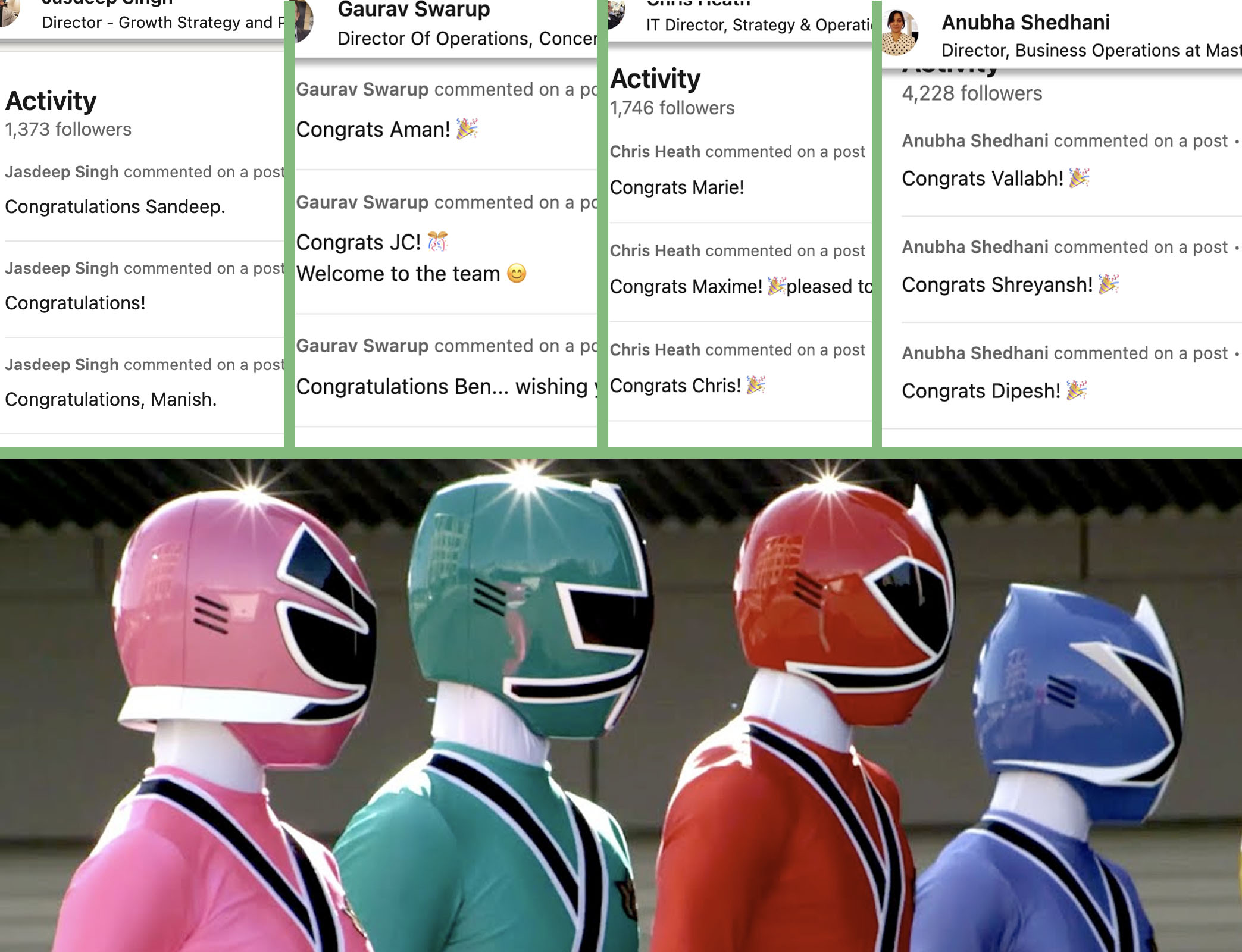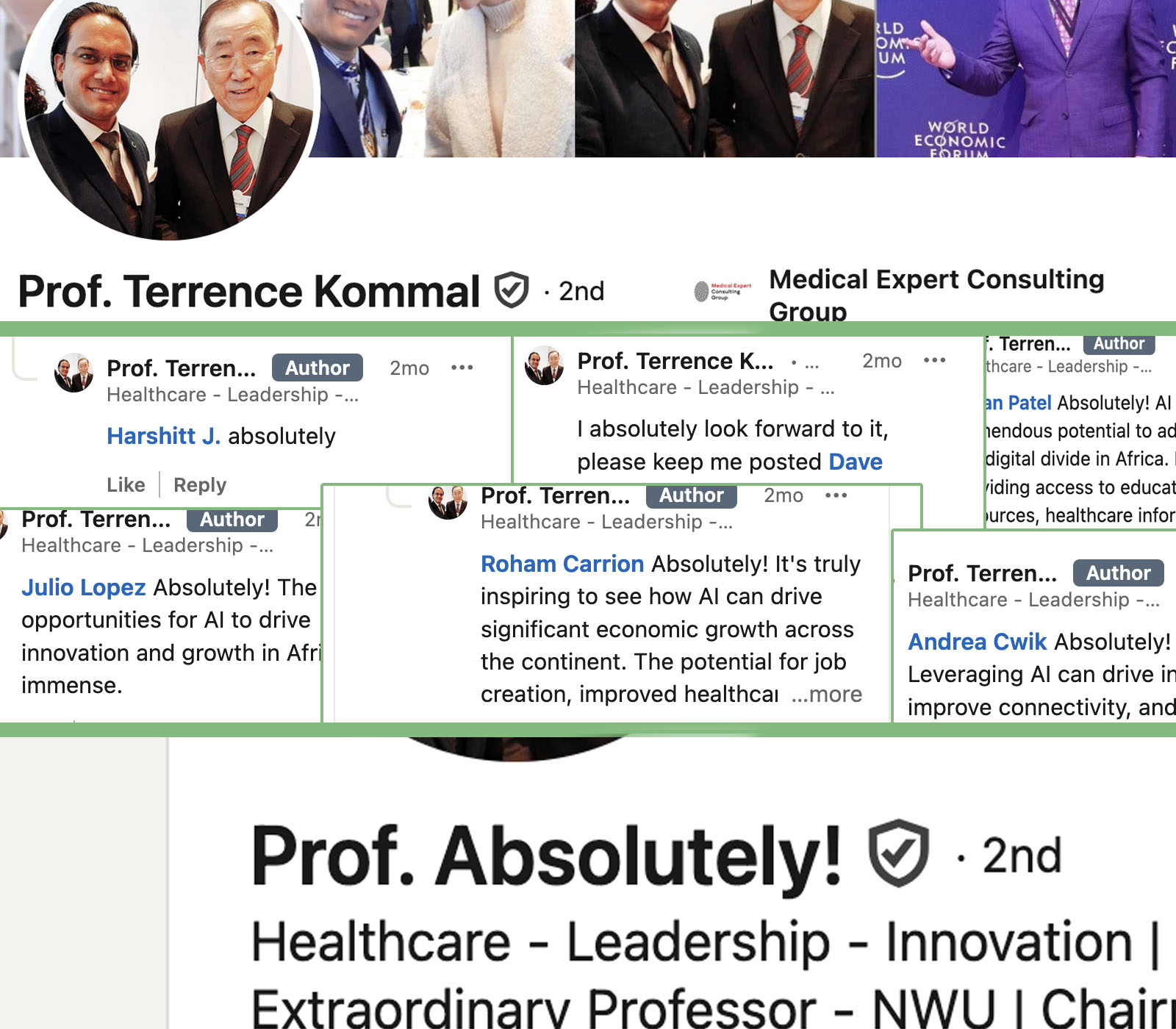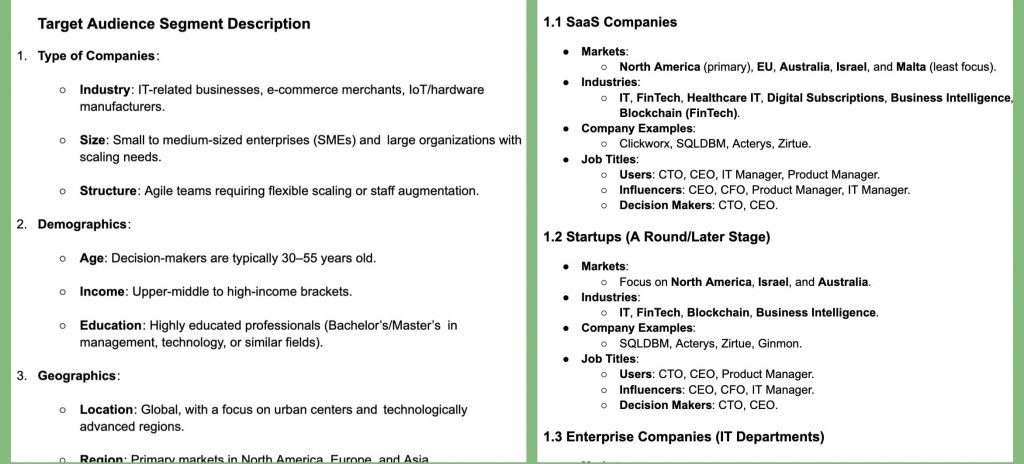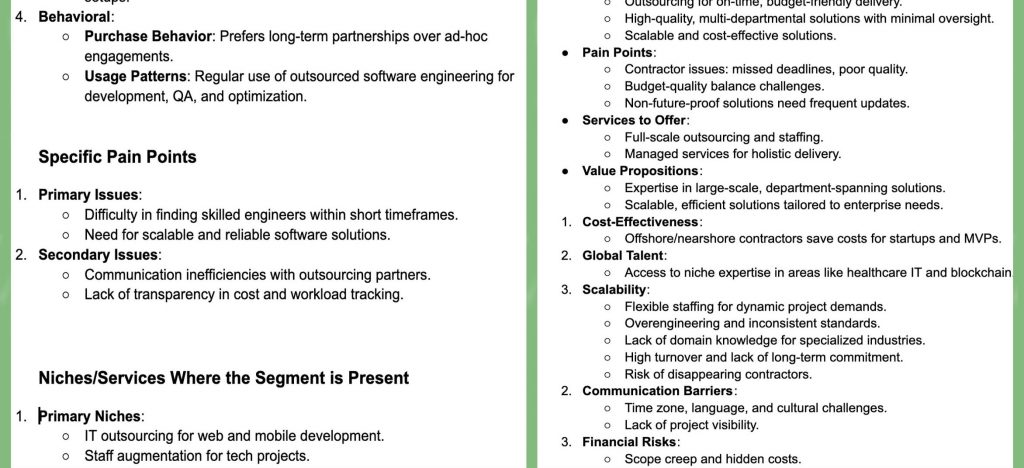Smarter Segmentation. Faster Results. Zero Fluff.
When your message hits the right audience, it’s like switching your readers on – they start engaging, taking action, and showing an overall interest in your brand. But when the targeting is lacking, it’s a completely different story. The audience tunes out, thinking, “This isn’t for me,” and your effort falls flat.
Why Understanding Your Target Audience Matters
Let’s take a look at the following examples:
1. Non-Personalized Message (Based on Industry – SaaS)
“Unlock advanced marketing tools designed for SaaS businesses. Our platform helps you grow faster and stay ahead of the competition.”
The only aspect that can trigger a reaction is a mention of the industry, but it’s too broad to attract attention.
2. Slightly Personalized Message (Based on Industry + Role)
“Marketing managers in SaaS businesses, gain full control over your campaigns with our purpose-built platform. Increase customer engagement by 30% and automate complex campaign processes effectively.”
This message sounds better, but better than nothing. If I were the marketing manager in SaaS, I’d pay attention. But it’s not enough to keep my attention longer than a moment.
3. Personalized Message (Based on Industry + Role + Company Size)
“As a marketing manager in a mid-sized SaaS company, you must scale your campaigns. Our platform uses AI to refine audience targeting and reduce your time spent on manual campaign adjustments.”
Better than the previous one, but still far from perfect. I would appreciate that the data defines me and my company, but I still wouldn’t be sure that this offer is right for me.
4. Heavily Personalized Message (Based on Industry + Role + Company Size + Pain Point)
“Mid-sized SaaS companies often face challenges in generating qualified leads. As a marketing manager, you need a platform that identifies high-conversion opportunities and decreases acquisition costs by 25%. Learn how our personalized AI solutions have increased lead volume by 45% for businesses like yours.”
This one is a more or less adequate offer. If I would fit the described criteria, I would at least consider it.
5. Hyper-Personalized Message (Based on Industry, Role, Company Size, Pain Point + Contextual Interactions)
“Are you a marketing manager at a mid-sized SaaS company struggling with lead generation and slow tech adoption? Our AI-powered platform integrates with tools like HubSpot and Salesforce to automate customer segmentation, reduce manual errors, and improve ROI by 60%. Discover how SaaS leaders have achieved a 70% boost in qualified leads by combining predictive analytics with tailored engagement strategies.”
Bingo! It covers everything needed to recognize yourself in the description and start considering the offer.
As you can see, each additional layer of personalization sharpens message relevance, making it increasingly specific, action-driven, and impactful. This process turns general marketing efforts into powerful campaigns that resonate with precise customer needs. This, in turn, transforms in a better return on marketing investments.
Comparison Table: Levels of Personalization in Marketing Messages
| Criteria | Non-Personalized | Slightly Personalized Messages | Personalized Messages | Heavily Personalized Messages | Hyper-Personalized Messages |
| Personalization | Generic | By a single broad criterion | By a couple of broad criteria | By a combination of broad and narrow criteria | By interaction data and predictive insights |
| ER | Low (avg. 10-20%) | Moderate (20-40%) | High (40-60%) | Very High (60-80%) | Extremely High (80-95%) |
| CTR | 0.5%-1% | 1%-2% | 2%-4% | 4%-8% | 8%-12% |
| CR | Minimal (0.2%-0.5%) | Low (0.5%-1%) | Moderate (1%-3%) | High (3%-6%) | Very High (6%-10%) |
|
ROI for $1 |
$0.5-$1 | $1.5-$2 | $3-$5 | $6-$8 | $10-$15 |
| Brand Perception | Generic, non-memorable | Some awareness through consistency | Trusted advisor in specific fields | Market leader with unmatched brand loyalty | Industry benchmark |
| Effort | Low | Moderate | High | Highest | Extensive |
Behind AI-Powered Personalization
Audience segmentation means crunching numbers and spotting patterns – something no human can do as fast or as accurately as AI. Let’s break the process down for better understanding.
Data Sources to Gather From
Building audience profiles that work means pulling from all the right data. Mix these sources, and you’ll have a strong foundation for your segmentation.
Behavioral Data
- What pages they visit, what they click, and how long they hang out online tell you what grabs their attention.
- Purchase patterns, from order sizes to frequency, show what they value.
- App usage reveals their go-to features and habits.
Demographic Data
- Basics like age, gender, income, and job roles help group your audience.
- Educational and career backgrounds can link to buying decisions.
Psychographic Data
- Beliefs, values, and lifestyles uncover their motivations.
- Hobbies and interests bring depth to your personas.
Geographic Data
- Location pinpoints where they are for region-specific campaigns.
- Cultural insights help you tap into what influences their choices.
Transactional Data
- Payment preferences reveal spending habits.
- Loyalty programs highlight your top-tier customers.
Engagement Data
- Social media activity (likes, shares, comments, etc.) shows how they feel about your brand.
- Email open and click rates tell you what’s hitting (or missing) the mark.
Segmentation Types
Here are the most common ways to segment your audience:
- Demographic segmentation. Based on age, gender, income, and education.
- Behavioral segmentation. Based on purchase habits, engagement, and loyalty patterns.
- Technographic segmentation. Leverages technology preferences and adoption rates.
- Psychographic segmentation. Considers values, beliefs, and motivations for in-depth insights.
- Dynamic segmentation. This type is aimed at changing the criteria as customer behavior evolves.
AI-Powered Data Analysis Techniques
- Predictive analytics. AI analyzes the historical data, identifies patterns, and predicts what customers will do next.
- ML clustering. Breaks your audience into micro-segments by analyzing loads of variables, and uncovering hidden trends.
- NLP. Dives into reviews, surveys, and feedback to understand what people think.
- Dynamic segmentation. Updates audience profiles in real-time as behaviors shift.
- Recommendation engines. Track actions to suggest products or services they’re likely to love.
My Approach to AI-Powered Audience Research
The approach to audience segmentation relies on social signals and uses the NLP technique for processing large amounts of various data types for extracting social signals.
Step 1. Broad Initial Analysis
First of all, I create a basic target audience segment descriptions. It’s quite simple because you already have everything you need: your offering and your target market.
Here is an illustrative example. I’ve just prompted my homebrew AI tool to conduct an initial analysis based only on the About page, which is surely not enough for adequate analysis. By the way, it created a basic description and didn’t even object.
Step 2. Persona Development
Drill deeper by crafting detailed personas for each segment. Capture their goals, frustrations, and behaviors. Who are they? What keeps them up at night? Build a story that feels real.
Basic persona creation is the same easy process. The secret lies in a comprehensive framework that effectively suggests feasible values for the target audience. Look at the persona whose characteristics at this stage are generic enough to be fully ideated yet make it possible to determine the real people matching:
Persona 1: The Scaling CTO
Name: Emily Carter
Role: Chief Technology Officer at a growing SaaS company
Age: 42
Location: San Francisco, CA, USA
Education: Master’s in Computer Science
Company size: 100-250 employees
Context:
Emily oversees the technical growth of her company. Her team is launching a new software product but faces skill gaps in key areas like backend development and QA. She needs a reliable partner to scale her development team without the delays of traditional hiring.
Goals:
- Scale her team quickly to meet product launch deadlines.
- Maintain high-quality output without micromanaging outsourced teams.
- Establish a long-term partnership for future projects.
Pain points:
- Shortage of skilled engineers in the local hiring market.
- Delays in scaling teams with freelancers.
- Difficulty in managing multiple outsourced vendors.
Triggers:
- Increased project backlog.
- Delays in delivering features due to understaffed teams.
Objections:
- Concern about transparency and hidden costs in outsourcing.
- Fear of miscommunication with remote teams.
Short story:
Emily’s team struggled to meet a critical product launch deadline. After choosing Valletta Software Development, she quickly onboarded a team of senior engineers who integrated seamlessly with her in-house staff. Transparent reports and daily sync-ups kept her updated, allowing her to focus on strategic priorities.
Here is my take that might be even eye-opening for some of you. Social activity matters a lot more than the formal criteria relevance. Look, by knowing only what the company offers, it’s safe to identify the roles of potential buying decision-makers. The location usually matches the target market, and the age, gender aren’t necessary at this step. So, it’s time to move forward.
Step 3. Champion identification
Well, let’s find the representatives of our personas. What I do at this step is just populate role, country, industry, and a couple of other fields in the LinkedIn search and then manually sort through the appropriate accounts.
This is when the above-mentioned rule of thumb comes into force. I don’t consider LinkedIn posts as donors of social signals because it would mostly be the social signals of AI. The share of valuable LinkedIn posts created manually is vanishingly small (forgive me those who write their posts manually), so I decided not to waste my time on searches.

A team of Congratsmen. Credit: me
Comments are also flooded with poorly crafted AI texts but the share of valuable signals among them is significantly higher. You should choose your champions carefully. There are hordes of both insufficiently active accounts (every other CTO doesn’t post and comment at all, for example) and those whom I call “blooperheroes” – accounts with the LinkedIn automation turned on, which results are usually weird. However, my practice showed that you can rely on 10-20% of your excerption.

Credit: me
Step 4. Data Collection
The process of data collection is iterative. As the data is analyzed, new details emerge, gradually unraveling the tangle. Once the first LinkedIn batch is processed, it becomes possible to expand the focus to other sources, sometimes even more valuable. Since I’m working with a tech audience, my favorites are:
- Hacker News (but pay attention, threads often contain outdated posts and comments)
- Slashdot
- Quora
- Also thinking about 4Chan but haven’t still tried it out.
My last take resulted in an analysis of 2,932 pages = 5,034 records (posts and comments from different sources) = 665,757 words. It’s obvious that I don’t do it manually. Moreover, I believe that data processing is exactly the main LLM use case, not these questions to Oracle a-la “show me my destiny”. Language models are just data-processing devices, neither more nor less.
Step 5. Refinement
After the extraction of valuable data, it’s time to adjust and expand the target audience analysis. You can see a completely different TA description after the refinement
Left part – before, right part – after, part 1. Credit: me
Left part – before, right part – after, part 2. Credit: me
With each next iteration, your profiles become more accurate and actionable, moving more and more tightly to what your audience needs. By the way, you’ll see a huge gap only after the first iteration.
Step 6. Integration
Now it’s time to turn the gathered insights insights into action. Use your TA segmentation to create marketing messages that hit sharp into their challenges and goals. This is where personalization meets precision.
Efforts and Outcomes
Building a detailed audience segmentation and content strategy doesn’t have to drag on for days. With the process I’m using, it’s done in less than a day.
Sometimes I conduct fast segmentation within 2 hours by analyzing smaller amounts of data. Taking into account the fact I don’t need any permissions or even inform clients, it makes a strong impression on potential clients when I do it within initial research.
Here is my tool, I hope you’ll find it helpful: Audience Investigator
Even better, the process works. I usually plan content based on detailed audience insights rather than chasing keywords from the start. Then, I still analyze keyword data as the validation measure, which usually results in 80%+ topics passing the validation.
Comparison with Customer Interviews
| Aspect |
Contactless Analysis |
Customer Interviews |
| Speed | Fast, powered by AI. | Slow – lots of scheduling and coordination. |
| Scalability | Can analyze 50+ Champions at once. | Limited to a handful of participants. |
| Independence | Zero reliance on client leadership or budgets. | Fully dependent on access and approvals. |
| Insights | Real-world data straight from Champions. | Filtered and sometimes biased answers. |
| Flexibility | Always evolving, based on fresh data. | Stuck with whatever you ask at the start. |
| Cost | Low – just AI tools and public data. | High – lots of time, effort, and incentives. |
Customer interviews are fine for certain things, but they’re slow, expensive, and limited in scope. My method moves faster, scales wider, and digs into real-world data that AI turns into actionable insights. It’s like combining the best parts of qualitative research with the power of AI – without the hassle. Perfect for campaigns that need to hit the mark, every time.
Wrapping Up
If you’re looking to create marketing strategies that truly connect, speed matters, precision matters, and independence matters. With the right tools and approach, you can hunt for insights that drive real results – faster, smarter, and with less hassle. The opportunities are right there – go grab them! And don’t hesitate to write me a line if the article turns out helpful for you.
The post Cracking the Code of Smarter Audience Segmentation appeared first on Datafloq.



